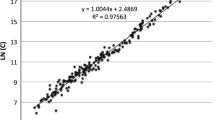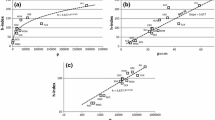Abstract
The quantity and quality of scientific output of the topmost 50 countries in the four basic sciences (agricultural & biological sciences, chemistry, mathematics, and physics & astronomy) are studied in the period of the recent 12 years (1996–2007). In order to rank the countries, a novel two-dimensional method is proposed, which is inspired by the H-index and other methods based on quality and quantity measures. The countries data are represented in a “quantity–quality diagram”, and partitioned by a conventional statistical algorithm into three clusters, members of which are rather the same in all of the basic sciences. The results offer a new perspective on the global positions of countries with regards to their scientific output.





Similar content being viewed by others
Notes
Further information available at: http://www.scimagojr.com.
Quoted in “Nation Master” website, available at: http://www.nationmaster.com/graph/peopop-people-population.
The population data for years 2006 and 2007 are supposed to be nearly the same as that of year 2005.
References
Ball, P. (2005). Index aims for fair ranking of scientists. Nature, 436(7053), 900.
Bornmann, L., & Daniel, H.-D. (2005). Does the H-index for ranking of scientists really work? Scientometrics, 65(3), 391–392.
Braun, T., Glänzel, W., & Schubert, A. (2006). A Hirsch-type index for journals. Scientometrics, 69(1), 169–173.
Division of Science Resources Statistics (SRS), NSF (2008). Science and Engineering Indicators (SEI) available at: http://www.nsf.gov/statistics/seind08/.
Gan, G., Ma, C. & Wu, J. (2007). Data clustering: theory, algorithms, and applications, ASA-SIAM Series on Statistics and Applied Probability. Philadelphia, ASA, Alexandria, VA: SIAM.
Hirsch, J. E. (2005). An index to quantify an individual’s scientific output, PNAS, 102(46): 16569–16572. arXiv:physics/0508025v5.
King, D. A. (2004). The scientific impact of nations. Nature, 430(6997), 311–316.
Rehn, C., Kronman, U., & Wadskog, D. (2007). Bibliometric Indicators Definitions and Usage at Karolinska Institute, ver. 1.0.
May, R. M. (1997). The scientific wealth of nations. Science, 275(5301), 793–796.
Schubert, A., & Braun, T. (1986). Relative indicators and relational charts for comparative assessment of publication output and citation impact. Scientometrics, 9(5–6), 281–241.
Science and Technology Indicator Project Team, NISTEP, MEXT (2004) Science and Technology Indicators: 2004, A Systematic Analysis of Science and Technology Activities in Japan available at: http://www.nistep.go.jp/achiev/ftx/eng/rep073e/idx073e.html.
UNESCO. (2005). UNESCO Science Report, available at: http://www.unesco.org/science/psd/publications/sciencereport2005.pdf.
Author information
Authors and Affiliations
Corresponding author
Rights and permissions
About this article
Cite this article
Nejati, A., Hosseini Jenab, S.M. A two-dimensional approach to evaluate the scientific production of countries (case study: the basic sciences). Scientometrics 84, 357–364 (2010). https://doi.org/10.1007/s11192-009-0103-1
Received:
Published:
Issue Date:
DOI: https://doi.org/10.1007/s11192-009-0103-1




